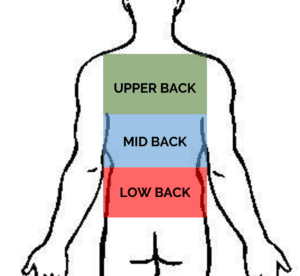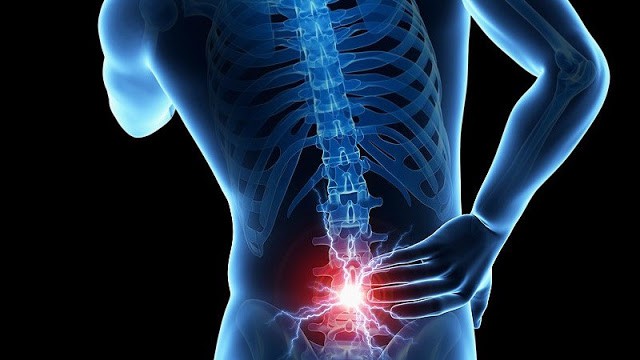The deadlift is one of the most technical barbell lifts, and there are many factors that can contribute to soreness in your lower back the next day. If you are experiencing back soreness after deadlifts, you may be asking “Is this normal? Is this really the way it’s supposed to feel?" I’m going to answer all of these questions for you. But first, let’s make an important distinction: Is your back sore? Or, does your back hurt?
Back Pain After Deadlifts
If you wake up in the morning with a sharp lower back pain after deadlifts the day before, or an inability to move your back or get out of bed (sudden loss of range of motion), this is not a normal response to deadlifting. Although it’s not normal, the good news is, it’s probably not serious.
First, do a quick check on yourself for red flags. Red flags are signs or symptoms that indicate that you may be experiencing a more serious underlying medical condition. Examples of these may include, but not limited to:
- Severe headache, blurred vision, or loss of vision
- Difficulty controlling bowel or bladder
- Numbness or shooting pain down both legs
- Changes in sensation around the genital region
Now that I’m done scaring you with all of the horrible things that could go wrong, the truth is, if you’re NOT experiencing any red flag symptoms, there’s a 90% chance your pain will go away within 6 weeks, regardless of what treatment you seek out.
Even better, with optimal self-management strategies, it should go away even quicker!
If you’re not experiencing any red flags, and you’re dealing with lower back pain after deadlifts, check out our following guides for what to do if you hurt your back lifting weights and how to overcome it in 24 hours.
These articles will take you step-by-step and show you exactly how to overcome your lower back pain from deadlifting. For now though, let’s talk more about back soreness.
Back Soreness After Deadlifts
Have you ever done a really intense upper body workout session, where you trained your chest or biceps with high reps? Then, in the next few days, you experienced intense muscle soreness? You know, the kind that feels good and let you know that you did something? That “feel the burn” soreness you experience 24-72 hours after your workout is better known as Delayed Onset Muscle Soreness (DOMS). It is usually due to one of two things:
- Performing exercises that repeatedly eccentrically load a muscle in a stretched position (muscle damage).
- Performing an exercise or movement that is new to you (novel stimulus).
That intense muscle soreness is usually caused by eccentric movements. An eccentric movement involves putting tension on the muscle as it lengthens (think “lowering” phase of a biceps curl). Muscle soreness can also result from repetitive concentric motion, although usually not as intense. Concentric movements involve creating tension in a muscle as it shortens (think “lifting” phase of a biceps curl).
Additionally, an isometric contraction occurs when tension is being applied to a muscle but no movement occurs (think pushing/pulling against an immovable object). While both concentric and eccentric motion can lead to muscle soreness, performing isometric work alone produces very little soreness. This is where the role of the low back comes into play. But before we start panicking…
Everyone is Sore After Trying Something New!
Here’s the truth. If it’s your first time deadlifting, and you wake up the next morning with back soreness, I wouldn’t be too concerned. You just tried something new! Think about all of the times you tried something new, or something your body wasn’t used to doing (i.e. hiking, moving furniture, ice skating) – it’s inevitable that you’re going to be sore the next day!
So if you have a sore lower back after deadlifts, and you’re relatively new to deadlifts, fear not. Give your body a chance to adapt!
If instead, you’re always dealing with low back soreness after each and every deadlift session, AND you’ve been consistently deadlifting for more than a month, listen up.
WHERE is Your Back Sore After Deadlifts?
For simplicity purposes, let’s split the back up into three parts: the lower, mid, and upper back (sorry anatomy folks!) The lower back would be right above your tailbone, the upper back would be in between your shoulder blades, and the mid back would be the area in between. While I just mentioned that back soreness is to be expected if you are new to deadlifts, the exact location can give us a little more insight. Where are you sore?

While you can expect all three of these areas to be sore after deadlifts if you are new to them, if you aren't new to them and you’re consistently and excessively sore in your lower back the day after deadlifts, this is NOT normal.
So what do you do? If you are experiencing lower back soreness after deadlifts, you need to make sure your form and programming is optimized. Check out our tutorial to see how your form matches up!
Common Form Faults that Can Contribute to Low Back Soreness After Deadlifts
If you watched the tutorial video above you will see that 5 simple steps – bend down, grab the bar, shins to bar, chest up, and pull, will help you get all of your joints into the optimal deadlift position. Sometimes, however, it’s not so simple. Here are some common form faults that can contribute to excessive back soreness after deadlifting.
Inability to Set and Maintain Spinal Position
If you’re performing the deadlift optimally, your low back should fight to maintain an isometric contraction the entire rep. And if you remember from above, isometric contractions rarely cause muscle soreness. This low back position is achieved in the starting position with the “chest up” cue.

In essence, picking the bar off the ground requires multiple muscle activation, but little eccentric activation. During the lift, concentric hip extension occurs while the lumbar spine stays rigid, firing isometrically.
Granted, as the weight gets heavy, and you approach your 1RM, or you’re performing higher reps, you will most likely flex more at the thoracic spine and achieve additional eccentric activation in the upper back. This rounding can contribute to DOMS in the upper back the following days, which is usually tolerable.
While thoracic rounding can be advantageous to pull heavier weight, you probably want to avoid excessive lower back rounding and loading into end-range lumbar flexion. Why? While the jury is still out on whether loading the lumbar spine into end range flexion will directly lead to pain and injury, due to the significant eccentric stresses it causes, it can contribute to continual low back soreness. So, if you limit the eccentric loading into end range flexion, you shouldn’t experience much low back soreness in the days following deadlifts.
Optimizing Your Hip Height During the Set Up
Another form fault I commonly see during the deadlift, is starting with the hips too high. Starting with the hips too high will limit quad contribution to the lift, and put excessive stress on the low back. Starting with the hips too high is usually caused by starting with the bar too close to the shins and the inability to get your elbows to your knees.
In an optimal deadlift, you want to start with the barbell 1-2” away from the shins, move your shins TOWARDS the bar, and get your knees to your elbows. This will set your hips at the correct height. This process is explained in the video below:
View this post on Instagram
Hips Shooting Up Too Soon
Another common form fault during the deadlift occurs when the hips rise prematurely. When your hips rise too quickly, your hamstrings are essentially winning the tug-of-war over your low back, causing your low back to lose its rigid positioning.
One way to tell if your hips are rising too soon, is to see if you’re losing contact between the bar and your legs. In an optimal deadlift, your legs should maintain contact with the bar for the entire rep. This will ensure that you’re keeping the load (the barbell) as close to your center of gravity as possible, and thus maximizing your mechanical efficiency.
To fix this, think about pushing through your quads, keeping your knees bent longer, and dragging the bar up your legs!
Common Deadlift Programming Errors
Now that we’ve covered all of the form errors that you can work on correctly, let’s talk about programming the deadlift. Is your back sore after deadlifts? You can have perfect deadlift form, but if you lift too much, too fast, and too often, this may be the reason why you're always sore! If exercise is medicine, we need to really start focusing on the dosage. Here are some common programming errors typically made with the deadlift:
Consistently Training at Too High of an Intensity
If you’re going into the gym every deadlift session to see how much you can lift, or how many reps you can achieve at a certain load, you’re not training…you’re TESTING.
If you’re doing this AND you’re experiencing either back pain after deadlifts or back soreness after deadlifting, no amount of form optimization is going to help. This is a programming error. To fix this, you need to start TRAINING (not testing) at an optimal intensity.
Optimizing RPE and Intensity
For those that train based on rate of perceived exertion (RPE) you should strive to get the majority of your working sets in at an RPE 7-8.5. For those that train intensity based, this correlates to about 80-86% 1RM.
Contrary to popular belief, you don’t need to consistently train above 90% or RPE 9 in order to promote increased strength! In fact, if you’re consistently getting the majority of your volume in at this level, it may be the reason why you’re always having back soreness after deadlifting! Back the intensity down a tad to see if this helps!
How to Utilize Back Down Sets
One way to modulate your training in order to keep intensity in the RPE 7-8.5 or 80-86% 1RM zone is to perform a top set followed by back off sets at a certain reduced percentage. For example. Let’s say you’re performing 4 sets of 3 on the deadlift. An appropriate intensity prescription may look like this:
Prescription: Perform a top set of 3 at RPE 8 and then reduce the intensity by 7% and perform 3x3.
Training Log:
- 375lb x 3 @ 8
- 350lb x 3 @ 7.5
- 350lb x 3 @ 8
- 350lb x 3 @ 8
As you can see in this scenario, you can achieve 4,275lbs of total tonnage in 12 total reps at an average RPE of 7.9. This is effective programming!
Putting it All Together
There are many factors you need to take into consideration if you’re dealing with low back soreness from deadlifting. If you’re relatively new to deadlifting and you’re experiencing some soreness, don’t worry…give your body some time to adapt to the new movement!
However, if you’re consistently dealing with a sore back after deadlifts and you’ve been at it for a while, you want to work on optimizing your form and programming.
Sometimes unfortunately no matter what you do, you may still experience back pain or soreness after the deadlift. In that case, after you’ve made all of the recommended changes listed above, you can try a different deadlift variation like the sumo or trap bar deadlift. More information can be found on that here.
No go out there, optimize your form and programming, and stop that annoying soreness in your low back after deadlifting!

